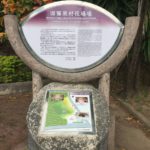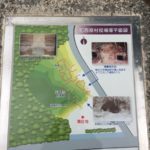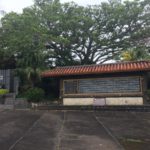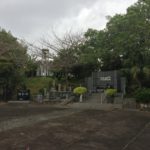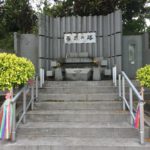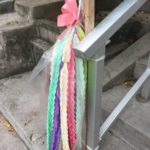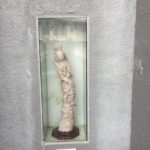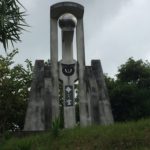Today, on a more solemn topic, I will introduce 2 sites I happened to pass by today in Nishihara-cho. Both sites are within a very short walking distance of each other. Park at the very small and narrow lot in front of the second site next to the Nishihara town office.
The first site is at the intersection just a few meters of town office. It is the Nishihara Village Wartime Underground Shelter 旧西原村役場壕跡, which has become a town cultural property. The underground shelter is a manmade limestone cave. While you cannot enter it, you can peek inside and see most of it.
There is a sign explaining in English. Briefly I will describe (or just read the photo below): In June of 1944 the war situation became increasingly severe, so Nishihara Village Hall local residents to dig an underground air-raid shelter. Inside, a 1-ton safe was kept to store important documents such as family registry, land register, public money, official seals, cash register, wartime bonds etc. It is one of the few artifacts left from the war and a reminder of the tragedy of war.
address: https://goo.gl/maps/W2rm2BKH2r42
The second site (this is the site you should park in front of!) is on the other side of the town office, the Nishihara Tower 西原の塔. This is a war memorial tower. It is also called 忠魂碑 Chuukonhi, a memorial monument for those that died in battle.
The tower was originally built as a dedication to those that died during WWI, “the Chinese Incident” (Second Sino-Japanese War), and the Russo-Japanese war.
It was destroyed in Battle of Okinawa (like most other things). After reconstruction, a pillar of remembrance was added for those that died during WWII and the Battle of Okinawa. Every October, a service is held to pray for peace and to pray for the deceased.
You will likely see origami cranes held together by strings, called senbazuru” 千羽鶴 which means 1000 cranes in Japanese. These are a symbol for hope and healing; . Common site at war memorials.
There are various pillars, monuments, walls with the names (and ages) of the many residents who died during these tragic times. About half of the village residents died in the Battle of Okinawa. There are also some images of bodhisattva, and some dedications to various infantry, battalions, etc.
address (park your car here!): https://goo.gl/maps/5mcX3DAgkG72
